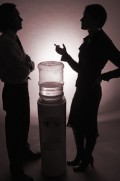 Gossip and rumours, they are the life force of cultural interaction. Just ask Guy Kawasaki, whose Truemors.com website took off last year, the hundreds of hacks who peddle the minutiae of celebrity lifestyles complete with the Photoshopped products of the paparazzi, or Perez Hilton. But, there is a serious side to rumours. In the midst of a natural disaster, terrorist atrocity, or war-torn location, the spread of rumours can mean the difference between life and death.
Gossip and rumours, they are the life force of cultural interaction. Just ask Guy Kawasaki, whose Truemors.com website took off last year, the hundreds of hacks who peddle the minutiae of celebrity lifestyles complete with the Photoshopped products of the paparazzi, or Perez Hilton. But, there is a serious side to rumours. In the midst of a natural disaster, terrorist atrocity, or war-torn location, the spread of rumours can mean the difference between life and death.
Informatics and e-business expert Judith Molka-Danielsen of Molde University College, Norway and public relations professional Thomas Beke of the University of Szeged, Hungary, explain how rumours affect how rational individuals assess risks, evaluate needs, and make decisions in disaster-affected environments. “Rumours play a confounding role in disaster management,” the researchers say.
In order to understand how rumours might propagate under extreme conditions and how a strategy to contain rumours, or enable “useful” rumours, to spread might be developed they have developed a definition of “rumour”. They point out that a rumour is essentially a message, but one with some degree of false content and a method of transporting the content. Two well-documented cases of technological and biological disaster events that led to loss of human welfare and economic losses and how the interplay of rumours in each cases underpinned the outcomes epitomise the definition: Chernobyl nuclear accident of 1986 and the tsunami that devastated Aceh in 2004.
Previous studies have suggested that immediately following a major disaster, “an atmosphere of fear, distrust and a scarcity of reliable information,” develops, within which people are “eager to circulate emotionally negative news, even if that news is exaggerated.” It is becoming apparent that relief agencies could use the rumour mill to spread accurate information to help those likely to be affected by a disaster rather than allowing the passive spread of misinformation to take place.
One might wonder whether such a positive rumour mill if it had been in place in China might have staved off the melamine in milk disaster that has been unfolding across Asia since well before the Beijing Olympics, now that tens of thousands of infants have been affected.
The researchers point out that no formal research has been presented to give relief coordinators a comprehensive understanding of the role of rumours in disaster management. There seems to have been no progress in this regard between major disasters and the relief efforts associated with them; erroneous and incomplete information exists in many real-world scenarios almost by default.
It is the imperfect state of information and its communication that are the fundamental preconditions in the birth of rumours. But rumours are something more than just misinformation and being misinformed. Rumours can have a viciously reinforcing and cascading affect on an existing state of falseness or existing communication problems. Disaster management agencies must therefore understand how to identify and address the phenomenon of rumours.
The team has developed a Rumour Object Enactment Model (ROEM), which defines the connections between different rumours and how they can affect the playout of relief work and human behaviour during a disaster. They used the cases of “Foot and mouth disease” (2001) and the “London underground bombings” (2005) for their detailed analysis to provide the underpinnings of their model.
Responsible agencies, the researchers suggest, could make use of their model to be able to identify how particular rumours start during a disaster and how they can be corrected or exploited to benefit those involved in the disaster.
It is essential for leaders, assistant groups or responsible authorities to understand the possible positive or potentially chaotic uses of rumours and the difficulty in predicting or controlling the boundaries of their dispersive domain. Decision makers with this knowledge will be better equipped to analyse the disaster environments and better able to respond to events in the presence of uncertainties.
Judith Molka Danielsen, Thomas Beke (2008). Rumours interplay in disaster management International Journal of Risk Assessment and Management, 9 (4) DOI: 10.1504/IJRAM.2008.020413